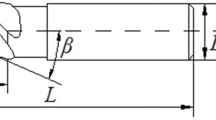Abstract
The primary objective of a machining economics model is to determine the optimal cutting parameters that minimize production costs while satisfying some design constraints. When the parameters in a machining economics model have interval values, the associated problem becomes an interval machining economics problem, and the objective value will also have interval value; that is, lying in a range. This paper develops a solution method that is able to derive the interval unit production cost of a machining economic model with interval parameters. A pair of two-level machining economics problems is formulated to calculate the upper bound and lower bound of the unit production cost. Based on the duality theorem, the two-level machining economics problem is transformed into the one-level conventional geometric program. Solving the corresponding pair of geometric programs produces the interval of the unit production cost. The results indicate that the cost interval contains more information for making decisions.
Similar content being viewed by others
References
Shin YC, Joo YS (1992) Optimization of machining conditions with practical constraints. Int J Prod Res 30:2907–2919
Armarego EJA, Smith AJR, Wang J (1993) Constrained optimization strategies and CAM software for single-pass peripheral milling. Int J Prod Res 31:2139–2160
Da AJ, Sadler JP, Fang XD, Jawahir IS (1995) Optimum machining performance in finish turning with complex grooved tool. ASME 2-1-3-1:703–714
Malakooti B, Zhou YQ, Tandler EC (1995) In-process regressions and adaptive multi-criteria neural networks for monitoring and supervising machining operations. J Intell Manuf 6:53–66
Prasad AVSRK, Rao PN, Rao URK (1997) Optimal selection of process parameters for turning operations in a CAPP system. Int J Prod Res 35:1495–1522
Wang J, Kuriyagawa T, Wei XP, Guo DM (2002) Optimization of cutting conditions for single-pass turning operations using a deterministic approach. Int J Mach Tools Manuf 42:1023–1033
Kaspi M, Shabtay D (2003) Optimization of the machining economics problem for a multistage transfer machine under failure, opportunistic and integrated replacement strategies. Int J Prod Res 41:2229–2247
Gopalakrishnan B, Al-Khayyal F (1991) Machine parameter selection for turning with constraints: an analytical approach based on geometric programming. Int J Prod Res 29:1897–1908
Narang RV, Fischer GW (1993) Development of a framework to automate process functions and to determine machining parameters. Int J Prod Res 31:1921–1942
Gupta R, Barta JL, Lai GK (1994) Profit rate maximization in multipass turning with constraints: a geometric programming approach. Int J Prod Res 32:1557–1569
Wang ZG, Wong YS, Rahman M (2004) Optimization of multi-pass milling using genetic algorithm and genetic simulated annealing. Int J Adv Manuf Technol 24:727–762
Baskar N, Asokan P, Saravanan R, Prabhaharan G (2005) Optimization of machining parameters for milling operations using non-conventional methods. Int J Adv Manuf Technol 25:1078–1088
Beightler CS, Philips DT (1976) Applied geometric programming. Wiley, New York
Childs T, Maekawa K, Obikawa T, Yamane Y (2000) Metal machining: theory and applications. Arnold, London
Lee YH, Yang BH, Moon KS (1999) An economic machining process model using fuzzy non-linear programming and neural network. Int J Prod Res 37:835–847
Bhattacharya A, Faria-Gonzalaz R, Ham I (1970) Regression analysis for predicting surface finish and its application in determination of optimum cutting conditions. Trans ASME 92:711–714
Peterson EL (2001) The fundamental relations between geometric programming duality, parametric programming duality, and ordinary Lagrangian duality. Ann Oper Res 105:109–153
Rajgopal J, Bricker DL (2002) Solving posynomial geometric programming problems via generalized linear programming. Comput Optim Appl 21:95–109
Duffin RJ, Peterson EL, Zenter C (1967) Geometric programming- theory and applications. Wiley, New York
Acknowledgements
This research was supported by the National Science Council of Republic of China under Contract NSC94-2416-H-238-001. The authors are indebted to the referees for their constructive comments that significantly improved the quality of this paper.
Author information
Authors and Affiliations
Corresponding author
Rights and permissions
About this article
Cite this article
Wang, RT., Liu, ST. An economic machining process model with interval parameters. Int J Adv Manuf Technol 33, 900–910 (2007). https://doi.org/10.1007/s00170-006-0525-3
Received:
Accepted:
Published:
Issue Date:
DOI: https://doi.org/10.1007/s00170-006-0525-3




